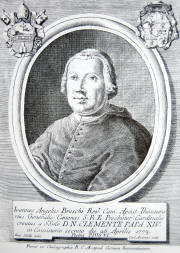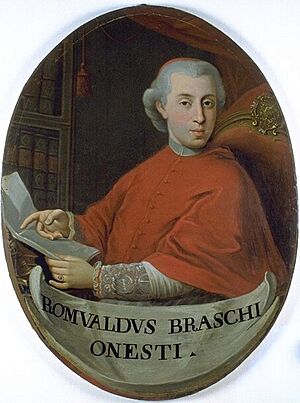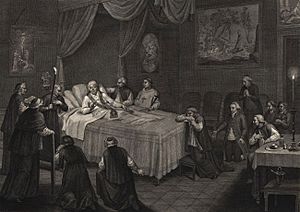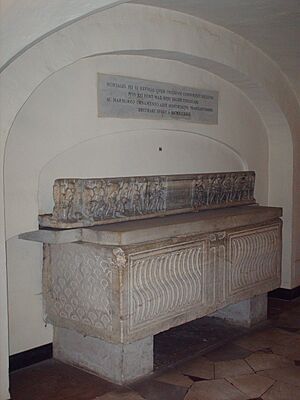Pope Pius VI facts for kids
Quick facts for kids Pope Pius VI |
|
|---|---|
| Bishop of Rome | |

Portrait by Pompeo Batoni, 1775
|
|
| Church | Catholic Church |
| Papacy began | 15 February 1775 |
| Papacy ended | 29 August 1799 |
| Predecessor | Clement XIV |
| Successor | Pius VII |
| Orders | |
| Ordination | 1758 |
| Consecration | 22 February 1775 by Gian Francesco Albani |
| Created Cardinal | 26 April 1773 |
| Personal details | |
| Birth name | Giovanni Angelo Braschi |
| Born | 25 December 1717 Cesena, Emilia-Romagna, Papal States |
| Died | 29 August 1799 (aged 81) Valence, French Republic |
| Previous post |
|
| Motto | Floret in Domo Domini (It blossoms in the house of God) |
| Coat of arms |  |
| Other Popes named Pius | |
Pope Pius VI (born Giovanni Angelo Braschi) led the Roman Catholic Church and ruled the Papal States from February 15, 1775, until his death in August 1799. His time as Pope lasted over two decades, making it one of the longest in history.
Pius VI strongly disagreed with the French Revolution and how it affected the Church in France. French soldiers, led by Napoleon Bonaparte, took over the Papal States in 1796. In 1798, Pius VI was taken prisoner and sent to France because he refused to give up his power as a ruler. He passed away 18 months later in Valence.
Biography
Early Life and Education
Giovanni Angelo Braschi was born on Christmas Day in 1717 in Cesena, Italy. He was the oldest of eight children.
He studied at the Jesuit college in Cesena. By 1734, he had earned a degree in both church law (canon law) and civil law. He then continued his studies at the University of Ferrara.
Becoming a Church Leader
Giovanni Braschi started his career as a private secretary to Cardinal Tommaso Ruffo. He traveled with Cardinal Ruffo to the papal election in 1740. Later, he became Cardinal Ruffo's assistant.
His good work in Naples impressed Pope Benedict XIV. In 1753, Pope Benedict XIV made Braschi one of his own secretaries. In 1755, he became a priest (canon) at St. Peter's Basilica.
In 1758, Braschi became a priest. He also took on roles like Referendary of the Apostolic Signatura. In 1766, Pope Clement XIII appointed him treasurer of the church's finances.
Becoming a Cardinal
Braschi was a very careful and hardworking administrator. This sometimes caused problems for others who preferred things to be less strict. To reduce his influence, Pope Clement XIV made him a Cardinal on April 26, 1773. He became the Cardinal-Priest of Sant'Onofrio. After this, he spent some time at the Abbey of Subiaco.
Papacy
How He Became Pope
| Papal styles of Pope Pius VI |
|
|---|---|
 |
|
| Reference style | His Holiness |
| Spoken style | Your Holiness |
| Religious style | Holy Father |
| Posthumous style | None |
After Pope Clement XIV died in 1774, a special meeting called a conclave was held to choose the next Pope. Countries like Spain, France, and Portugal agreed to elect Braschi. He was seen as a moderate choice.
Some people who disliked the Jesuits supported Braschi, thinking he would continue the previous Pope's policies against them. However, those who supported the Jesuits also hoped he would help their order. This meant Pope Pius VI had a difficult task ahead, trying to please both sides.
Cardinal Braschi was elected Pope on February 15, 1775. He chose the name "Pius VI." He was officially made a bishop on February 22, 1775, and crowned Pope on the same day.
First Steps as Pope
One of Pius VI's first actions was to open a special holy year, the 1775 Jubilee Year, which his predecessor had planned.
Early in his papacy, Pius VI promised to make reforms and fix corruption in the Papal States. He criticized the governor of Rome for not dealing with corruption. He also formed a group of cardinals to improve the state's money situation and reduce taxes. He tried to stop wasteful spending and encouraged farming.
The Society of Jesus
After becoming Pope, Pius VI ordered the release of Lorenzo Ricci, the leader of the Society of Jesus, who was held in Castel Sant'Angelo. However, Ricci died before he could be freed. It is believed that Pius VI helped the Jesuits avoid being completely dissolved in some areas like White Ruthenia and Silesia.
In 1792, the Pope thought about bringing back the Society of Jesus everywhere. He saw them as a strong group that could stand against the new ideas of the French Revolution. However, he did not go through with this plan.
Challenges to Papal Authority
Pius VI faced challenges from new ideas that wanted to limit the Pope's power. One writer, using the name "Febronius," wrote about national Catholic Churches, similar to the Gallican ideas in France. Even though this writer later took back his statements, his ideas were adopted in Austria.
In Austria, Emperor Joseph II made changes to the Church that seemed to threaten the Pope's authority. Because of this, Pius VI took the unusual step of traveling to Vienna in 1782 to meet the Emperor. Although he was welcomed, his trip did not succeed in stopping the changes. However, a few years later, he did manage to stop some German archbishops from trying to gain more independence at a meeting in 1786.
Changes in Other Countries
In the Kingdom of Naples, a liberal minister named Tanucci pushed for changes regarding the Pope's feudal rights, and some agreements were made. More serious disagreements arose with Leopold II (who later became emperor) and Bishop Scipione de' Ricci in Tuscany. They proposed liberal reforms to the Church there. In 1794, Pope Pius VI issued a special document called Auctorem fidei to condemn these ideas.
Other Important Actions
On August 17, 1775, Pope Pius VI officially declared the authenticity of Our Lady of Šiluva, a Marian apparition.
Pius VI also saw the growth of the Catholic Church in the United States of America. He freed the American clergy from the control of the Vicar Apostolic in England. In November 1789, he created the first American diocese, the Diocese of Baltimore.
During his time as Pope, Pius VI appointed 73 new cardinals. He did not declare any new saints, but he beatified 39 people, including Lawrence of Brindisi and Amato Ronconi.
The Pope also improved the finances of the Papal States. He is well-known for expanding the Pio-Clementine Museum, which was started by his predecessor. He also tried to drain the Pontine Marshes and successfully drained marshes near other cities. He restored the Via Appia road and improved the harbors of Terracina and Porto d'Anzio. Pius VI was a great supporter of the arts and learning. He also added a new sacristy to Saint Peter's Basilica.
The French Revolution
When the French Revolution began in 1789, Pius VI saw the old Church in France being suppressed. Church property in France was also taken. He believed these events were against God's plan and a plot against the Church. The Pope spoke out against the Declaration of the Rights of Man and of the Citizen and the Civil Constitution of the Clergy. He supported groups that opposed the revolution. He issued two important letters, Quod aliquantum (1791) and Caritas (1791), to condemn the proposed church reforms.
In 1791, diplomatic relations with France ended, and the Pope's representative was called back to Rome. One reason for this break was that revolutionaries seized the Comtat Venaissin, ending 516 years of Papal rule in Avignon.
King Louis XVI of France was executed on January 21, 1793. His daughter asked Rome to declare her father a saint. On June 17, 1793, Pius VI called the late king a martyr, suggesting he might become a saint. However, in 1820, the Church decided it was not possible to prove the king died for religious reasons rather than political ones. Pius VI believed the revolution was mainly against the Catholic religion and King Louis XVI. He also wrote that the French revolutionaries got rid of "the monarchy, the best of all governments."
Capture and Death Under Napoleon
In 1796, French Republican troops led by Napoleon Bonaparte invaded Italy and defeated the Pope's army. The French took over Ancona and Loreto. Pius VI asked for peace, which was agreed upon in February 1797. However, in December 1797, a French general was killed in a riot in Rome. This gave Napoleon a new reason to invade.
General Berthier marched into Rome without resistance on February 10, 1798. He declared a Roman Republic and demanded that the Pope give up his power as a ruler.
Pius VI refused. He was taken prisoner on February 20 and escorted from the Vatican to Siena, then to a monastery near Florence. When France declared war on Tuscany, he was moved again. He traveled through several cities before arriving at the citadel of Valence, France. He died there six weeks later, on August 29, 1799. He had reigned longer than any pope before him.
Pius VI's body was preserved but not buried until January 30, 1800. Napoleon decided it was politically helpful to bury the Pope in an effort to bring the Catholic Church back into France. His companions wanted him buried in Rome. They also prevented a French bishop from leading the burial service, as French law required, so no service was held. This conflict was resolved later.
Pius VI's body was moved from Valence on December 24, 1801. He was finally buried in Rome on February 19, 1802, with a Catholic funeral attended by his successor, Pope Pius VII.
Reburial
In 1949, Pope Pius XII ordered that Pius VI's remains be moved to the Chapel of the Madonna below St. Peter's Basilica in the Vatican grottos. His remains were placed in an old marble coffin. An inscription above it reads:
"The mortal remains of Pius VI, consumed in unjust exile, by order of Pius XII were placed fittingly here and decorated by a marble ornament most excellent for its art and history in 1949".
See also
 In Spanish: Pío VI para niños
In Spanish: Pío VI para niños
- Cardinals created by Pius VI
- List of popes
- Luis Ignatius Peñalver y Cárdenas
- Palazzo Ghini






